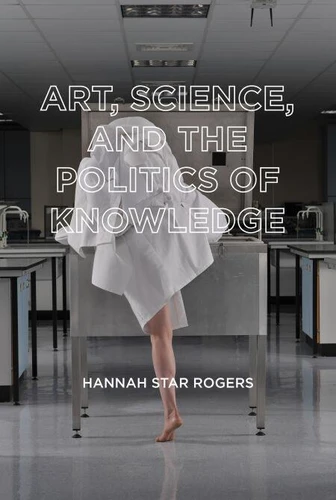Art, Science, and the Politics of Knowledge
Par : , ,Formats :
Disponible dans votre compte client Decitre ou Furet du Nord dès validation de votre commande. Le format ePub protégé est :
- Compatible avec une lecture sur My Vivlio (smartphone, tablette, ordinateur)
- Compatible avec une lecture sur liseuses Vivlio
- Pour les liseuses autres que Vivlio, vous devez utiliser le logiciel Adobe Digital Edition. Non compatible avec la lecture sur les liseuses Kindle, Remarkable et Sony
- Non compatible avec un achat hors France métropolitaine
 , qui est-ce ?
, qui est-ce ?Notre partenaire de plateforme de lecture numérique où vous retrouverez l'ensemble de vos ebooks gratuitement
Pour en savoir plus sur nos ebooks, consultez notre aide en ligne ici
- Nombre de pages328
- FormatePub
- ISBN978-0-262-36959-6
- EAN9780262369596
- Date de parution17/05/2022
- Protection num.Adobe DRM
- Taille2 Mo
- Infos supplémentairesepub
- ÉditeurThe MIT Press
Résumé
How the tools of STS can be used to understand art and science and the practices of these knowledge-making communities. In Art, Science, and the Politics of Knowledge, Hannah Star Rogers suggests that art and science are not as different from each other as we might assume. She shows how the tools of science and technology studies (STS) can be applied to artistic practice, offering new ways of thinking about people and objects that have largely fallen outside the scope of STS research.
Arguing that the categories of art and science are labels with specific powers to order social worlds-and that art and science are best understood as networks that produce knowledge-Rogers shows, through a series of cases, the similarities and overlapping practices of these knowledge communities. The cases, which range from nineteenth-century artisans to contemporary bioartists, illustrate how art can provide the basis for a new subdiscipline called art, science, and technology studies (ASTS), offering hybrid tools for investigating art-science collaborations.
Rogers's subjects include the work of father and son glassblowers, the Blaschkas, whose glass models, produced in the nineteenth century for use in biological classification, are now displayed as works of art; the physics photographs of documentary photographer Berenice Abbott; and a bioart lab that produces work functioning as both artwork and scientific output. Finally, Rogers, an STS scholar and contemporary art-science curator, draws on her own work to consider the concept of curation as a form of critical analysis.
Arguing that the categories of art and science are labels with specific powers to order social worlds-and that art and science are best understood as networks that produce knowledge-Rogers shows, through a series of cases, the similarities and overlapping practices of these knowledge communities. The cases, which range from nineteenth-century artisans to contemporary bioartists, illustrate how art can provide the basis for a new subdiscipline called art, science, and technology studies (ASTS), offering hybrid tools for investigating art-science collaborations.
Rogers's subjects include the work of father and son glassblowers, the Blaschkas, whose glass models, produced in the nineteenth century for use in biological classification, are now displayed as works of art; the physics photographs of documentary photographer Berenice Abbott; and a bioart lab that produces work functioning as both artwork and scientific output. Finally, Rogers, an STS scholar and contemporary art-science curator, draws on her own work to consider the concept of curation as a form of critical analysis.
How the tools of STS can be used to understand art and science and the practices of these knowledge-making communities. In Art, Science, and the Politics of Knowledge, Hannah Star Rogers suggests that art and science are not as different from each other as we might assume. She shows how the tools of science and technology studies (STS) can be applied to artistic practice, offering new ways of thinking about people and objects that have largely fallen outside the scope of STS research.
Arguing that the categories of art and science are labels with specific powers to order social worlds-and that art and science are best understood as networks that produce knowledge-Rogers shows, through a series of cases, the similarities and overlapping practices of these knowledge communities. The cases, which range from nineteenth-century artisans to contemporary bioartists, illustrate how art can provide the basis for a new subdiscipline called art, science, and technology studies (ASTS), offering hybrid tools for investigating art-science collaborations.
Rogers's subjects include the work of father and son glassblowers, the Blaschkas, whose glass models, produced in the nineteenth century for use in biological classification, are now displayed as works of art; the physics photographs of documentary photographer Berenice Abbott; and a bioart lab that produces work functioning as both artwork and scientific output. Finally, Rogers, an STS scholar and contemporary art-science curator, draws on her own work to consider the concept of curation as a form of critical analysis.
Arguing that the categories of art and science are labels with specific powers to order social worlds-and that art and science are best understood as networks that produce knowledge-Rogers shows, through a series of cases, the similarities and overlapping practices of these knowledge communities. The cases, which range from nineteenth-century artisans to contemporary bioartists, illustrate how art can provide the basis for a new subdiscipline called art, science, and technology studies (ASTS), offering hybrid tools for investigating art-science collaborations.
Rogers's subjects include the work of father and son glassblowers, the Blaschkas, whose glass models, produced in the nineteenth century for use in biological classification, are now displayed as works of art; the physics photographs of documentary photographer Berenice Abbott; and a bioart lab that produces work functioning as both artwork and scientific output. Finally, Rogers, an STS scholar and contemporary art-science curator, draws on her own work to consider the concept of curation as a form of critical analysis.



